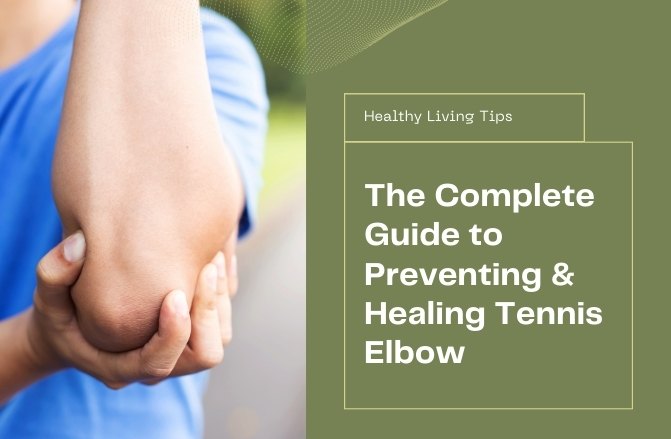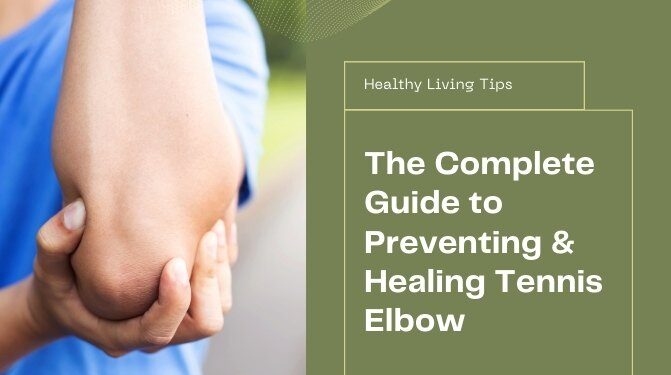
Tennis elbow isn’t just a problem for tennis players—it can affect anyone who grips, lifts, or moves their arm repetitively. Whether you’ve struggled with it before or just want to avoid the pain altogether, taking preventative steps is key.
The best way to keep your elbows strong and pain-free? A combination of smart movement, proper technique, and strengthening exercises. In this guide, we’ll break down what tennis elbow is, why it happens, and—most importantly—how to stop it before it starts.
Table of Contents
What Exactly Is Tennis Elbow?
Tennis elbow—also known as lateral epicondylitis—happens when the tendons in your forearm become overworked and irritated. These tendons connect your forearm muscles to your elbow joint, helping control wrist and hand movement. Over time, repetitive stress can cause tiny tears, leading to pain, stiffness, and reduced grip strength.
Despite its name, tennis elbow isn’t just a sports injury. Everyday activities like typing, gardening, lifting weights, or even using a screwdriver can strain these tendons. If left unchecked, the discomfort can linger for months or even years. According to the National Health Service (NHS), tennis elbow can take over a year to heal.
The good news? You don’t have to wait for an injury to take action. Strengthening your arm, improving your form, and making small adjustments to daily movements can significantly lower your risk.
How Do You Know If You’re at Risk?
The first signs of tennis elbow often sneak up on you—a little stiffness here, a dull ache there. At first, it might seem like nothing, but over time, the discomfort can turn into sharp pain that makes everyday movements difficult.
Here’s what to watch for:
✔️ Pain that gets worse with movement – You might feel a dull ache or sharp pain when lifting, gripping, or twisting your arm.
✔️ Stiffness or weakness – Struggling to shake hands, grip objects, or fully extend your arm? That’s a red flag.
✔️ Tenderness and inflammation – The area around your elbow may feel sore or swollen, especially after repetitive activity.
✔️ Pain that radiates – The discomfort may start at the elbow but can spread down to your forearm and wrist.
Ignoring these early signs can lead to a longer recovery time if an injury develops. That’s why prevention is key—and up next, we’ll go over the best ways to keep your elbows strong and pain-free.
How to Keep Tennis Elbow from Happening in the First Place
Tennis elbow isn’t just an issue for athletes—it can develop from any repetitive arm movement, whether you’re lifting weights, typing all day, or using tools. The good news? A few small changes in technique, equipment, and daily habits can go a long way in preventing strain and injury.
1. Use the Right Grip and Technique
One of the biggest causes of tennis elbow is gripping too tightly or using improper form. Whether you’re holding a tennis racket, a dumbbell, or even a computer mouse, keep these tips in mind:
✔️ Loosen your grip – A death grip puts unnecessary strain on your tendons. Hold objects firmly, but don’t squeeze harder than needed.
✔️ Engage your whole arm – Instead of relying only on your wrist and elbow, use your shoulder and upper arm to absorb force.
✔️ Adjust your hand position – If you play sports or use tools, ensure your wrist is in a neutral (not bent or strained) position.
2. Be Mindful of Overuse
Repetitive motions without enough rest can wear down your tendons over time. To prevent this:
✔️ Take frequent breaks – If your job or hobby involves repetitive arm movements, pause every 20–30 minutes to rest and stretch.
✔️ Switch hands when possible – Alternate tasks between both hands to avoid overloading one arm.
✔️ Ease into new activities – If you’re picking up a new sport or workout routine, build up gradually instead of doing too much too soon.
3. Support Your Elbow with the Right Gear
Using the right equipment can reduce strain and improve comfort. A few options to consider:
✔️ Wear an elbow brace – If you’re prone to tennis elbow, a counterforce brace can help distribute pressure and reduce stress on your tendons.
✔️ Use ergonomic tools – If you spend hours typing, using a wrist-friendly mouse and keyboard can help prevent strain.
✔️ Choose the right sports equipment – A lighter racket or cushioned grip can ease stress on your forearm.
4. Keep Your Arm Flexible and Mobile
Tight muscles can contribute to tendon strain, so keeping your arms, shoulders, and wrists flexible is key. Even simple daily stretches can help prevent stiffness and reduce injury risk.
By making small adjustments to your daily habits, technique, and gear, you can greatly reduce your chances of developing tennis elbow—keeping your arms strong, pain-free, and ready for action.
What to Do If You Already Have Tennis Elbow
If you’re already dealing with elbow pain, don’t worry—most cases heal on their own with the right care. Instead of relying on medication or waiting for it to go away, you can speed up recovery with a few simple treatments. In fact, research shows this injury commonly resolves spontaneously without medical intervention.
1. Rest, But Don’t Stop Moving Completely
Your elbow needs time to heal, but total inactivity can lead to stiffness. The key is to avoid painful activities while keeping your arm mobile.
✔️ Limit heavy lifting, gripping, or twisting movements.
✔️ Use an elbow brace or strap to reduce strain.
✔️ Avoid sleeping on your affected arm to prevent unnecessary pressure.
2. Reduce Pain and Swelling Naturally
✔️ Apply ice packs for 10–15 minutes at a time, several times a day.
✔️ Gently massage the forearm to improve circulation and loosen tight muscles.
✔️ Consider anti-inflammatory options like over-the-counter pain relievers, but only if needed.
3. Ease Back Into Movement with Gentle Exercises
Once the pain starts to improve, light movement is key to recovery. Simple wrist and grip exercises help restore strength and flexibility—more on that in the next section!
Tennis elbow takes time and patience to heal, but with rest, care, and the right exercises, you’ll be back to normal sooner.
The Best Physiotherapy Exercises for Tennis Elbow
Once your pain starts to improve, physiotherapy exercises can help rebuild strength and prevent future injuries. The goal is to gradually restore mobility, reduce stiffness, and strengthen your tendons—but remember to listen to your body and start slow.
1. Loosen Up with a Gentle Massage
Before diving into exercises, a soft tissue massage can help release tightness and ease discomfort.
✔️ For a wrist extensor massage, gently knead your forearm muscles for a few minutes using your opposite hand.
✔️ Apply light pressure on sore areas, but avoid pressing too hard.
2. Strengthen Your Grip
Improving your grip strength is a key part of recovery. Start with these:
✔️ Tennis ball squeeze – Hold a tennis ball or soft stress ball, squeeze for 5 seconds, then release. Repeat 10–15 times.
✔️ Towel twists – Hold a loosely rolled towel, twisting your hands in opposite directions as if wringing out water.
3. Rehabilitative Exercises to Restore Movement
These exercises focus on endurance and movement recovery to restore tendon health.
✔️ Elbow bend – Lower your arm to your side and slowly bend your elbow, bringing your hand toward your shoulder. Hold for a few seconds, then lower it again.
✔️ Wrist rotations – Hold a light weight or a rolled-up towel with your thumb pointing up. Slowly turn your wrist inward, hold for a second, then turn outward. Repeat.
4. Improve Wrist Mobility and Strength
Your wrist plays a big role in elbow health. These exercises help restore movement and build endurance:
✔️ Wrist flexor stretch – Extend your arm, palm up, and gently pull your fingers back toward you. Hold for 20–30 seconds.
✔️ Wrist extensor stretch – Extend your arm, palm down, and gently pull your fingers toward you.
✔️ Controlled wrist curls – Rest your forearm on a flat surface with your wrist hanging over the edge. With a light weight, gently raise and lower your wrist.
Gym-Friendly Exercises to Strengthen Your Elbow
If you’re recovering from tennis elbow but still want to stay active at the gym, the key is to avoid high strain while focusing on controlled, low-impact movements. These exercises use light weights and slow, intentional motions to rebuild strength without aggravating your injury.
1. Wrist Curls for Forearm Strength
Wrist curls target the muscles that support your elbow and wrist. Start with a light dumbbell (1-2 lbs) or resistance band.
✔️ How to do it:
- Rest your forearm on a bench or table with your wrist hanging over the edge, palm facing up.
- Slowly curl your wrist upward, then lower it back down.
- Repeat 10–15 times for 2–3 sets.
🔹 Tip: Keep the movement slow and controlled to avoid straining your tendons.
2. Reverse Wrist Curls to Build Balance
Just like wrist curls, reverse wrist curls strengthen the opposite side of your forearm, preventing muscle imbalances.
✔️ How to do it:
- Position your forearm the same way as a wrist curl, but with your palm facing down.
- Slowly lift your wrist upward, then lower it.
- Perform 10–15 reps for 2–3 sets.
3. Wrist Turns for Flexibility and Control
This exercise improves wrist rotation strength, which is essential for gripping and lifting without pain.
✔️ How to do it:
- Hold a light weight or a small towel with your palm facing up.
- Slowly rotate your wrist so your palm faces down, then return to the starting position.
- Repeat for 10–12 reps on each side.
🔹 Tip: If you’re using a dumbbell, keep your movements controlled—avoid swinging.
By adding these low-impact, controlled movements into your workout routine, you’ll strengthen your forearm muscles without risking re-injury. Stick with light weights and high reps, and focus on proper form over intensity.
Stretching Exercises to Keep Your Elbow Loose and Pain-Free
Stretching is one of the best ways to regain movement and reduce stiffness without putting extra strain on your tendons. These simple stretches improve flexibility, relieve tension, and support long-term elbow health.
1. Wrist Extensor Stretch (Relieves Tension in the Forearm)
This stretch targets the muscles that often become tight with tennis elbow.
✔️ How to do it:
- Extend your arm straight in front of you, palm facing down.
- Use your other hand to gently pull the back of your hand toward you until you feel a stretch in your forearm.
- Hold for 20–30 seconds, then relax.
- Repeat 2–3 times on each arm.
🔹 Tip: Keep your arm straight and avoid bending your elbow to get the full stretch.
2. Wrist Flexor Stretch (Loosens the Inner Forearm Muscles)
This stretch works the opposite muscles of the wrist extensor stretch, helping maintain balance.
✔️ How to do it:
- Extend your arm straight in front of you, palm facing up.
- Use your opposite hand to gently pull your fingers back toward your body.
- Hold for 20–30 seconds, then relax.
- Repeat 2–3 times on each arm.
🔹 Tip: If this stretch feels too intense, ease into it gradually.
By incorporating these gentle stretches into your routine, you’ll improve flexibility, circulation, and recovery, helping to prevent future flare-ups.
Healing from Tennis Elbow: Stay Consistent and Patient
Recovering from tennis elbow takes time, consistency, and patience—but with the right approach, you can get back to pain-free movement.
✔️ Listen to your body – Avoid activities that cause sharp pain, but keep your arm moving with gentle stretches and strengthening exercises.
✔️ Stick to a routine – Regular exercises, proper technique, and rest will speed up healing and prevent reinjury.
✔️ Be patient – Tendons heal slowly, so don’t rush. Progress may take weeks or months, but every small improvement counts. The NHS recommends listening to your pain levels to ensure you’re not pushing too hard.
By following these steps, you’ll build strength, prevent future issues, and keep your elbows healthy for the long run. Stay consistent, and you’ll see results!
























